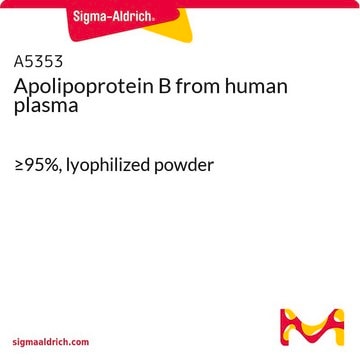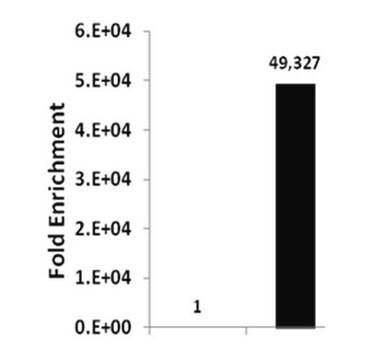03-198
RIPAb+ IGF2 mRNA-binding protein 3 - RIP Validated Antibody and Primer Set
from rabbit, purified by affinity chromatography
Sinónimos:
IGF II mRNA binding protein 3, IGF-II mRNA-binding protein 3, IGF2 mRNA-binding protein 3, KH domain containing protein overexpressed in cancer, KH domain-containing protein overexpressed in cancer, VICKZ family member 3, insulin-like growth factor 2 mRN
About This Item
Productos recomendados
origen biológico
rabbit
Nivel de calidad
clon
polyclonal
purificado por
affinity chromatography
reactividad de especies
canine, mouse, human
reactividad de especies (predicha por homología)
chimpanzee (based on 100% sequence homology), dog (based on 100% sequence homology), horse (based on 100% sequence homology), rhesus monkey (based on 100% sequence homology)
fabricante / nombre comercial
RIPAb+
Upstate®
técnicas
RIP: suitable
immunoprecipitation (IP): suitable
western blot: suitable
Nº de acceso NCBI
Nº de acceso UniProt
Condiciones de envío
dry ice
Información sobre el gen
human ... IGF2BP3(10643)
Descripción general
IGF2 mRNA-binding protein 3 contains several KH domains, which are important in RNA binding and are known to be involved in RNA synthesis and metabolism.
Especificidad
Inmunógeno
Aplicación
Representative lot data.
RIP lysate from HeLa cells (~2 X 10E7 cell equivalents per IP) was subjected to immunoprecipitation using 5 µg of either a normal Rabbit IgG, (Cat. # PP64B), or 5 µg of Anti-IGF2 mRNA-binding protein 3 antibody (Cat. # CS207310). Ten percent of the precipitated proteins (lane 1: Rabbit IgG, lane 2: IGF2 mRNA-binding protein 3) were resolved by electrophoresis, transferred to nitrocellulose and probed with anti-IGF2 mRNA-binding protein 3 antibody (Cat. # CS207310, 1:1000). Proteins were visualized using One-Step IP-Western kit (GenScript Cat. # L00231) Arrow indicates IGF2 mRNA-binding protein 3. The lower band in lane 2 correspond to the isoform 2.
Western Blot Analysis:
Representative lot data.
HEK293 cell lysate was resolved by electrophoresis, transferred to PVDF membranes and probed with IGF2BP3, (1:2,000) dilution. Proteins were visualized using a Donkey anti-Rabbit conjugated to HRP using a chemiluminescence detection system.
Arrow indicates IGF2BP3 (~64 kDa).
Epigenetics & Nuclear Function
Growth Factors & Receptors
RNA Metabolism & Binding Proteins
Envase
Calidad
Representative lot data.
RIP Lysate prepared from HepG2 cells (2 X 10E7 cell equivalents per IP) were subjected to immunoprecipitation using 5 µg of either a normal Rabbit IgG or 5 µg of Anti-IGF2 mRNA-binding protein antibody and the Magna RIP® RNA-Binding Protein Immunoprecipitation Kit (Cat. # 17-700).
Successful immunoprecipitation of IGF2 mRNA-binding protein 3-associated RNA was verified by qPCR using RIP Primers IGF2, (Figure 1).
Please refer to the Magna RIP (Cat. # 17-700) or EZ-Magna RIP (Cat. # 17-701) protocol for experimental details.
Descripción de destino
Forma física
Normal Rabbit IgG. One vial containing 125 μg of rabbit IgG in 125 μL of storage buffer containing 0.05% sodium azide. Store at -20°C.
RIP Primer IGF2, Part # CS207311.
One vial containing 75 μL of 5 μM of each primer specific for human IGF2 mRNA. Store at -20°C.
FOR: GCG GCT TCT ACT TCA GCA G
REV: CAG GTG TCA TAT TGG AAG AAC
Almacenamiento y estabilidad
Handling Recommendations: Upon receipt, and prior to removing the cap, centrifuge the vial and gently mix the solution. Aliquot into microcentrifuge tubes and store at -20°C. Avoid repeated freeze/thaw cycles, which may damage IgG and affect product performance. Note: Variabillity in freezer temperatures below -20°C may cause glycerol containing solutions to become frozen during storage.
Nota de análisis
Includes negative control normal rabbit IgG antibody and control primers specific for the cDNA of human IGF2.
Otras notas
Información legal
Cláusula de descargo de responsabilidad
Código de clase de almacenamiento
12 - Non Combustible Liquids
Punto de inflamabilidad (°F)
Not applicable
Punto de inflamabilidad (°C)
Not applicable
Certificados de análisis (COA)
Busque Certificados de análisis (COA) introduciendo el número de lote del producto. Los números de lote se encuentran en la etiqueta del producto después de las palabras «Lot» o «Batch»
¿Ya tiene este producto?
Encuentre la documentación para los productos que ha comprado recientemente en la Biblioteca de documentos.
Nuestro equipo de científicos tiene experiencia en todas las áreas de investigación: Ciencias de la vida, Ciencia de los materiales, Síntesis química, Cromatografía, Analítica y muchas otras.
Póngase en contacto con el Servicio técnico








